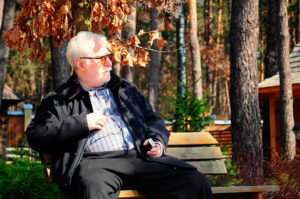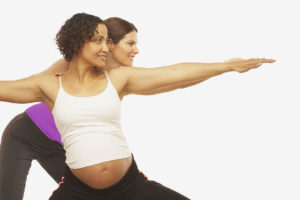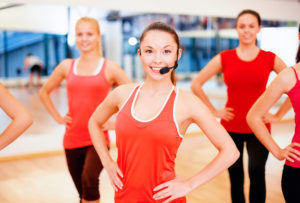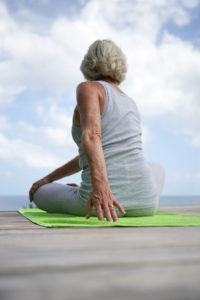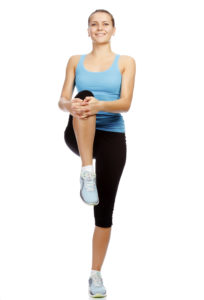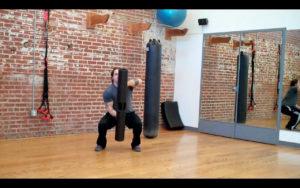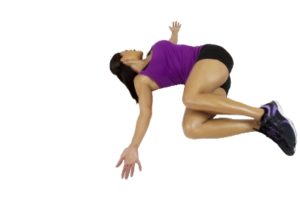Warm Ups/Cool Downs
“Do your clients perform stretches before a workout, or do they do a dynamic warm-up and then static stretching at the end?”
We do a dynamic warm-up to raise body temperature, which raises heart rate and increases circulation to muscles, tendons and ligaments. A dynamic warm-up also helps prepare the mind and body for the upcoming workout, enhances performance and reduces injuries.
I even use dynamic warm-ups when I teach yoga. Most Baby Boomers (and I am one of them) need dynamic warm-ups.
Help Students With “Tech Neck”
Have you noticed an increase in postural deviations among your students? In today’s society, “tech neck” is becoming more common—we all spend too much time looking down at our devices. This requires rounding the shoulders (rather than keeping them back and down, with chest open) and jutting the head forward. The position is becoming so habitual for a lot of people that it feels fixed and “natural” to them. Help participants become more aware of this uncomfortable trend and empower them to make better choices.
Myofascial Release vs. Dynamic Stretching for Improved Performance
There’s some debate about which protocol—myofascial release or dynamic stretching—is best for improving muscular strength, flexibility and power. A new study contributes to that discussion.
The crossover study included 14 NCAA Division I football offensive linemen who were tested on vertical jump power and velocity, knee isometric torque and hip range of motion. Subjects performed tests at baseline and after completing the following protocols: no treatment control, deep-tissue foam rolling (DTR) and dynamic stretching.
A Stability Ball Warm-Up That Targets the Entire Body
Get the workout party started with a standby piece of equipment.
How to Get Older Adults to Sit Less
Many of today’s older adults sit for long periods of time. A new study suggests that regular phone calls can motivate this group to get out of their chairs more often.
Fit to Travel
Whether we’re vacationing with our family or heading to the 2015 IDEA World Fitness ConventionTM with 12,000 other fitness enthusiasts, it can be challenging to stay fit when we’re on the road. Even the healthiest exercise professionals can get caught off-guard with aches, pains, stress and guilt that prevent us from having fun and functioning at our best.
If travel throws the fittest of us off track, imagine what it does to everyone else.
Mind-Body Personal Training
When Tanya Colucci, MS, trains clients, she pulls from many different resources to offer the best results possible. Owner of Tanya Colucci Myofascial Release Therapy in Bluffton, South Carolina, Colucci believes in an integrative mind-body approach, which appears to resonate with many people. Case in point: client Aileen Worthington, age 71, who has osteoporosis.
Self Myofascial Release for Seniors
Did you know it’s important to take care of the fascia—or connective tissue—in your body? The health of connective tissue is a serious concern for older people, as movement restrictions can make it hard for them to perform simple activities of daily living. The condition of our connective tissue depends on two factors—how old we are and what we have done in our lives to keep our tissue healthy, hydrated and flexible.
Prehabilitation Strengthening Exercises for Knee and Hip Arthroplasty
Fitness professionals may work in concert with a physical therapist to encourage a client to engage in “prehab” to maintain or enhance his strength preoperatively for knee or hip arthroplasty. (Shakoor et al. 2010). Pain is often a limiting factor, and it may be difficult for the client to participate in even the most basic daily activities. Below are a few suggested exercises.
KNEE ARTHROPLASTY
Isometric quadriceps sets. Lie on back with legs extended. Tighten quads and push knee into mat/surface. Hold 10 seconds. Do 10 repetitions, 5 times per day.
Make Them Stay!
It’s happened to every group fitness instructor: Time-crunched participants pick up (or abandon) their equipment and leave before the end of the experi- ence. Not only does this create a distrac- tion, but it prevents these students from reaping the benefits that occur in the final phase. How do you get people to stay? Read on for tips on how to encourage everyone to remain in class until the close.
Why Stay?
Stretching That Works for Men
Many men struggle with inflexibility and diminished joint range of motion, especially as they age, and stretching is often the most poorly performed component of their exercise programs. You can help male participants to develop an effective active-stretching program by incorporating continuously looped resistance bands into your cool-down. This approach may help men with over tight hips to restore agility, strength, power and balance.
Keep the following principles in mind when you cue form:
Seniors and Self Myofascial Release
The condition of our connective tissue depends on two factors—how old we are and what we have done in our lives to keep our tissue healthy, hydrated and flexible.
The health of connective tissue is a serious concern for older people, as movement restrictions can make it hard for them to perform simple activities of daily living. While personal trainers often develop flexibility programs and modify exercises to help senior clients succeed, there is another valuable technique to improve seniors’ range of motion.
Roll Out to Warm Up
If you’re looking for a fresh, effective way to help your group participants move better, why not include foam rolling in your next class? Chances are some of your attendees are curious and could use some guided instruction.
This simple foam roller warm-up uses self-myofascial-release (SMR) techniques to warm up the fascia, allowing tissues to move more freely. Trauma, irritation, repetitive use and a sedentary lifestyle create stiffness and can shorten the muscles and/or fascia. A few minutes of SMR offers many benefits.
Shared Stretching
It’s important to end a hard workout with a proper cool-down to ensure that participants transition safely to “regular” activity. Teamwork is a focus in most boot camp classes, and partner stretches create a social environment where people can interact and find support.
Supine Hip Press
With Partner Plank
Playful Warm-Ups in the Water
Aquatic exercise is a great way to get and stay in shape. In addition to being a fantastic cross-training option and full- body workout, exercising in the pool helps the body stay balanced. A water workout might not be the first thing your class participants think of when they’re looking to shape up and slim down—but perhaps it should be. Water fitness burns calories, boosts metabolism and strengthens muscles without putting extra stress on joints.
Functional Strategies for Older Adults
Exercise for older adults is one of the hottest specialties in fitness today. How do you assess function levels and develop safe, challenging programs? We asked instructors to tell us about their strategies for senior clients.
Stretching’s Impact on Strength
To stretch or not to stretch for improved strength is a question that endures. Some support the practice; others don’t. A new study may have put the debate to rest.
Movement and Tissue Preparation
As a group fitness instructor, you already know the value of a warm-up and how it decreases injury risk and improves performance. Recently, our collective vernacular has expanded to include movement preparation (prep) and/or tissue prep as interchangeable terms for warm-up.
Stretches for Positive Aging
Do you know that one of the most effective, inexpensive and pain-free ways to look and feel younger is to exercise and perform daily stretches that ward off kyphosis (rounding…



